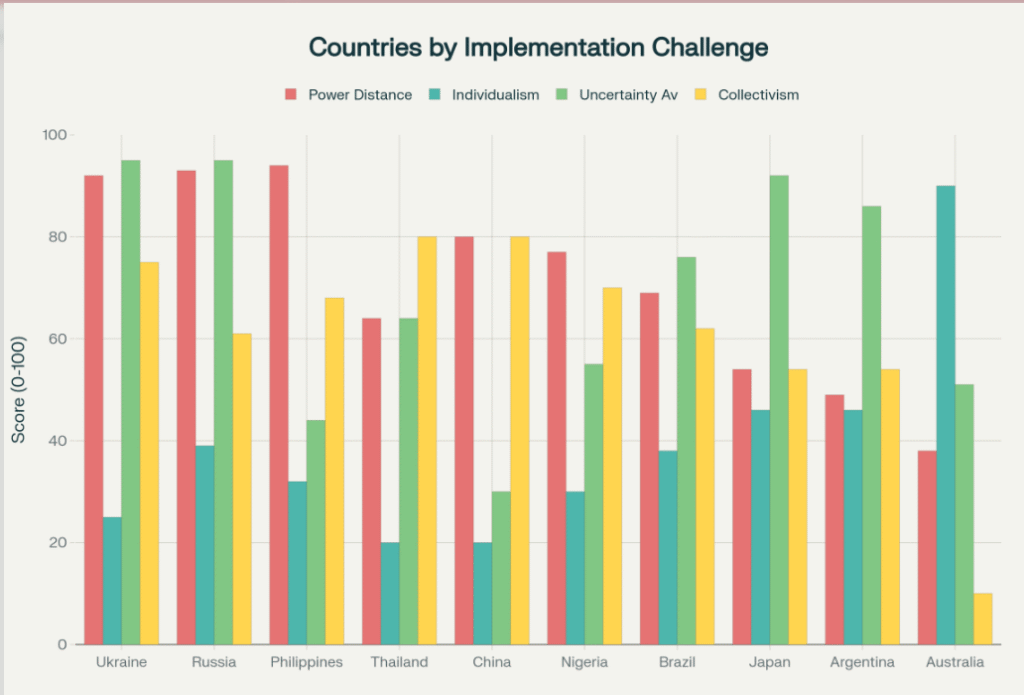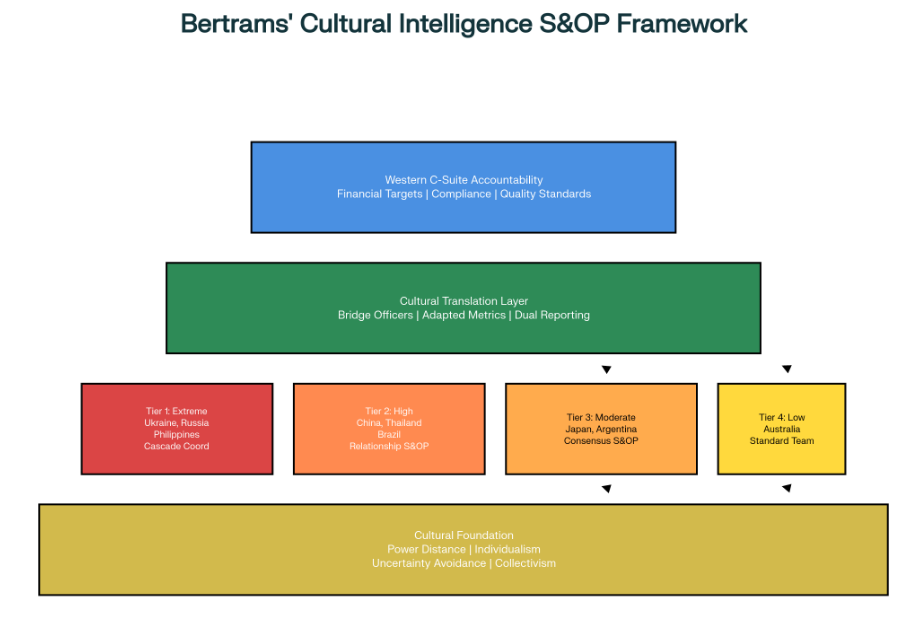Regional Analysis of Leadership Realignment Challenges
The “First Team” principle, which requires leaders to prioritize their peer relationships over their direct reports, faces some cultural implementation challenges across various global regions. While this approach may align well with Western individualistic and egalitarian cultures, it encounters substantial resistance in cultures characterized by high power distance, collectivism, face-saving concerns, and paternalistic leadership expectations.
Bertrams-coordinating-complexity.com provides a Cultural Intelligence S&OP/IBP Implementation Framework that solves the critical challenge of most of our multinational corporations:
- We will achieve consistent business outcomes, while facing generic local cultural expectations, which are blocking the outcome of digitizations and other business expectations.
Our “Cultural Dimension Analysis” (CDA):

Cultural Dimensions Analysis: Countries ranked by difficulty from highest (Ukraine) to lowest (Australia), based on cultural dimensions that create resistance to peer-prioritized leadership
Each color in our diagram acts as a code on related charts, helping readers spot which cultures may face challenges in adopting the First Team leadership model, based on their scores for these four dimensions.
Cultural Dimensions Explained
- Power Distance (Red)
This dimension measures how much less powerful members of a society accept and expect that power is distributed unequally. High Power Distance cultures typically have strict hierarchies, and people expect leaders to act as authority figures rather than as equals. In such contexts, it is more challenging to implement peer-focused leadership because subordinates expect leaders to protect their interests over collaborating with peers. - Individualism (Blue)
Individualism represents the degree to which people in a culture prioritize their own goals and identity over group objectives. High Individualism cultures value self-reliance, independence, and personal achievement, making them more receptive to the First Team principle because leaders are comfortable prioritizing organizational or peer group goals above their direct report relationships. - Uncertainty Avoidance (Green)
This dimension measures a culture’s tolerance for ambiguity and unstructured situations. High Uncertainty Avoidance cultures prefer clear rules, stability, and predictable leadership behaviors, which can create resistance to leadership changes like the First Team principle. People in these cultures look for certainty from their leaders rather than adaptability and frequent collaboration with peers. - Collectivism (Yellow)
Collectivism is the counterpart to Individualism and refers to the degree to which people in a society prioritize group loyalty, relationships, and harmony above personal interests. High Collectivism makes it difficult for leaders to prioritize peer relationships over their own teams, as the cultural expectation is that leaders serve and protect their group first.
Extreme Challenge (Score 80-85)
1. Ukraine (Challenge Score: 84.95)
- Power Distance: 92 – Extreme hierarchical expectations
- Individualism: 25 – Very low, indicating strong in-group loyalty obligations
- Uncertainty Avoidance: 95 – Highest score, requiring strict rules and predictability
- Collectivism: 75 – Very high group loyalty expectations
Ukraine faces the most severe implementation challenges due to the combination of extreme power distance, very low individualism, maximum uncertainty avoidance, and high collectivism. Leaders are culturally expected to protect their teams first and maintain predictable hierarchical patterns.
2. Russia (Challenge Score: 79.00)
- Power Distance: 93 – Highest hierarchical expectations globally
- Individualism: 39 – Low, with authoritarian paternalism
- Uncertainty Avoidance: 95 – Extreme need for control and predictability
- Collectivism: 61 – Moderate-high with vertical orientation
Russia’s authoritarian culture creates fundamental incompatibility with peer collaboration. The combination of extreme power distance and uncertainty avoidance reinforces command-control structures.
Very High Challenge (Score 70-75)
3. Philippines (Challenge Score: 72.30)
- Highest power distance globally (94) with paternalistic family-style leadership expectations
- Strong emotional bonds between leaders and subordinates supersede peer relationships
4. Thailand (Challenge Score: 71.20)
- High collectivism (80) and low individualism (20) create strong in-group protection expectations
- Cultural concept of “kreng jai” makes prioritizing peers over teams difficult
5. China (Challenge Score: 70.00)
- Guanxi networks and mianzi (face) concerns dominate formal peer structures
- Personal relationship obligations compete with institutional peer relationships
High Challenge (Score 60-70)
6. Nigeria (Challenge Score: 69.45)
- High power distance (77) with traditional Ubuntu leadership expectations
- Community-based loyalty and autocratic-benevolence patterns
7. Brazil (Challenge Score: 67.25)
- Paternalistic collectivism with protective leadership expectations
- “Jeitinho brasileiro” emphasizes personal relationships over formal structures
8. Japan (Challenge Score: 61.60)
- Senpai-kohai system requires hierarchical respect despite moderate power distance
- Extreme uncertainty avoidance (92) requires consensus-building and face-saving
Moderate Challenge (Score 55-60)
9. Argentina (Challenge Score: 58.65)
- Personalismo creates family-style team dynamics
- Lower power distance than other Latin American countries but still relationship-focused
Low Challenge (Score 25-30)
10. Australia (Challenge Score: 28.00)
- Power Distance: 38 – Lowest among all regions analyzed
- Individualism: 90 – Highest, supporting peer-focused structures
- Uncertainty Avoidance: 51 – Moderate, allowing flexibility
- Collectivism: 10 – Lowest, reducing competing loyalties
Australia’s egalitarian culture, flat hierarchies, and direct communication style create natural alignment with First Team principles.
High-Resistance Region: African Cultures
African leadership cultures generally present significant challenges to First Team implementation due to traditional Ubuntu philosophy and familism structures. Many African cultures maintain high power distance expectations where leaders are viewed as paternal figures responsible for their subordinates’ welfare.
The concept of autocratic-benevolence prevalent in African leadership styles creates expectations that leaders will prioritize their direct reports’ needs over peer relationships. Traditional African leadership emphasizes community responsibility and elder respect, which often translates to leaders feeling obligated to protect and prioritize their immediate teams.
Implementation Strategy for Bertrams |Coordinating Complexity|
Initial Action Proposal:
- Cultural Audit: Assess each region’s cultural resistance level using the ranking system
- Leadership Cultural Training: Mandatory cultural intelligence development for western executives
- Pilot Adapted Processes: Test culturally modified S&OP/IBP in highest resistance regions first
- Cultural Bridge Hiring: Recruit local cultural translation experts
Long-term Approach:

Our comprehensive strategy is built on a four-layer implementation architecture that maintains Western C-suite accountability while eliminating cultural resistance through intelligent adaptation:
Core Philosophy: “Same Outcomes, Different Methods”
Rather than forcing cultural change, Bertrams enables organizations to achieve consistent global business results through culturally intelligent execution strategies that respect regional leadership traditions while meeting Western corporate standards.
Four-Tier Regional Implementation Strategy
Based on our cultural resistance analysis, we provide differentiated approaches:
Tier 1: Extreme Resistance (Ukraine, Russia, Philippines)
Challenge Score: 80-85
Solution: Cascade Coordination Model
- Regional leaders maintain authoritative decision-making while participating in peer consultation
- Peer discussions become “Strategic Advisory Sessions” rather than collaborative decision-making
- Western requirements are “absorbed and translated” by regional leaders for local teams
- Cultural Buffer Systems protect local teams from direct Western cultural pressure
Tier 2: High Resistance (China, Thailand, Brazil)
Challenge Score: 67-72
Solution: Relationship-First S&OP
- Extended Relationship Building: 3-6 months of relationship development before process implementation
- Guanxi-Style Networking and personal connection development between regional peers
- Face-Saving Communication with indirect feedback mechanisms
- Collective Prosperity Framing presenting peer collaboration as regional family benefit
Tier 3: Moderate Resistance (Japan, Argentina)
Challenge Score: 58-67
Solution: Honor-Based Peer Collaboration
- Nemawashi Processes for behind-the-scenes consensus-building
- Professional Honor Framing presenting peer prioritization as organizational service duty
- Respect-Based Protocols maintaining hierarchy while building horizontal relationships
Tier 4: Low Resistance (Australia)
Challenge Score: 28
Solution: Standard First Team Implementation
- Direct application of Western methodologies with optimization focus
- Best Practice Development serving as model regions for cross-cultural learning
Implementation Timeline and Process
Bertrams 24-Month S&OP/IBP Cultural Implementation Roadmap: Structured approach to deploying culturally intelligent planning processes across global regions
Our 24-month structured implementation approach ensures sustainable cultural adaptation:
Phase 1: Cultural Assessment & Leadership Preparation (Months 1-6)
- Comprehensive cultural dimension analysis for each region
- Western executive cultural intelligence training
- Cultural bridge officer recruitment and training
- Resistance pattern identification and mitigation planning
Phase 2: Relationship Building & Adaptation Design (Months 4-9)
- Regional leader cultural coaching and development
- Peer relationship development programs
- Culturally adapted S&OP/IBP process design
- Local stakeholder engagement and buy-in creation
Phase 3: Pilot Implementation (Months 10-15)
- Tier-specific pilot programs in controlled environments
- Cultural feedback integration and process refinement
- Success pattern identification and documentation
- Risk mitigation and adaptation optimization
Phase 4: Scaled Rollout & Optimization (Months 16-24)
- Full regional implementation with ongoing support
- Cross-cultural best practice sharing and learning
- Continuous cultural adaptation and improvement
- Performance measurement and optimization
Risk Mitigation and Support Services
Comprehensive Risk Management
- Cultural Backlash Prevention: Extensive relationship building before process implementation
- Western Executive Impatience Management: Clear timeline expectations and cultural education
- Performance Degradation Protection: Pilot implementation with controlled risk exposure
- Organizational Fragmentation Prevention: Clear distinction between core requirements and cultural methodologies
Strategic Value Creation
- Cultural intelligence as core organizational competency
- Enhanced global leadership development capabilities
- Improved cross-cultural innovation and problem-solving
- Stronger local market relationships and competitive positioning
Key Differentiators from our competition:
- Scenario-based Planning and Implemention of S&OP/IBP
- Tier-specific implementation strategies tailored to regional resistance levels
- Dual–leadership development support
- Proven risk mitigation and success measurement frameworks
